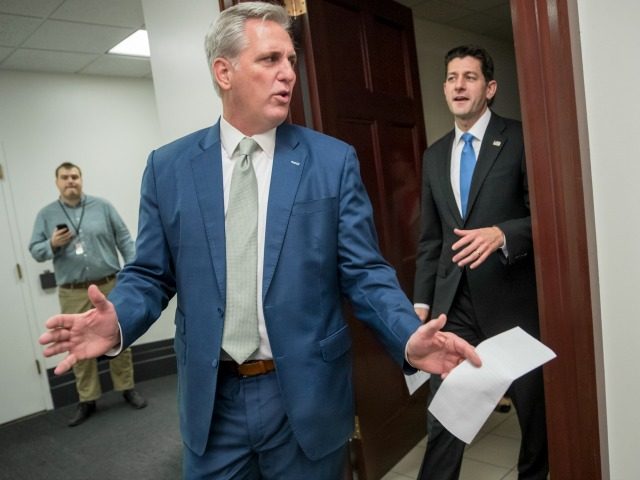House Majority Leader Kevin McCarthy won’t disappoint Republican voters during the argument over immigration policy and amnesty for illegals, said Rep. Raul Labrador, one of four GOP co-authors of a major immigration and amnesty policy bill.
“I think he will be strong on this,” Labrador told Breitbart News. Labrador continued:
I think he likes our bill. I don’t know if he’s going to champion it, but he also has a future that he needs to think about. He needs to decide whether he will stand with the American people or not and I think he will …
I think it is imperative that we stand strong on this issue. Right now the Democratic base is energized and if you want to energize the Republican base, the best thing you can do is keep your promises [to voters]. The worst thing you can do in 2018 is cave to Democrats on immigration because the base will not show up, so the Democrats will then take over the House and the Senate
The issue is a test for McCarthy’s leadership, Labrador said:
The [2018] national campaign for both the House and the Senate needs to be that the Republicans understand the importance of security at the border and security at home, and the Democrats are willing … to protect an illegal population. I just don’t see how that is a winning formula.
Labrador is elected from Idaho and will leave the House this year to run for governor. He chairs the judiciary committee’s panel on immigration and border security, and he co-authored the GOP’s “Securing America’s Future Act” immigration-and-amnesty bill.
McCarthy’s growing role has been a pleasant surprise for immigration reformers who are already worried about the prominent role in the amnesty dispute being played by GOP Sen. John Cornyn.
Cornyn and McCarthy are the two GOP leaders who have been planning negotiations on amnesty with top Democrats, Sen. Dick Durbin and Rep. Steny Hoyer. The pair of Coryn and McCarthy has overshadowed the role played by leading GOP immigration experts, including Sen. Chuck Grassley and Rep. Bob Goodlatte, who chair the Senate and House judiciary committees.
McCarthy represents an agricultural district where there is intense business pressure for imported cheap labor, despite the growing variety of labor-saving agricultural machinery. He is based in California, where massive legal and illegal immigration has also allowed Democrats to grab complete domination of state politics — and the ability every ten years to reshape political districts to their advantage. Both those political factors pressure McCarthy away from embracing the populist demand for a low-immigration/high-wage national economic policy.
But McCarthy stunned immigration reformers at the January 9 White House meeting when Democratic Sen. Diane Feinstein asked Trump to endorse a quick, no-strings ‘DACA’ amnesty while postponing border security measures to a subsequent debate. McCarthy intervened, saying:
Let’s be honest. Security was voted on just a few years ago, and, no disrespect, there’s people in the room on the other side of the aisle who voted for it. If I recall, Senator [Hillary] Clinton voted for it. So I don’t think that’s comprehensive; I think that’s dealing with DACA at the same time. I think that’s really what the President is making. It’s kind of like three pillars: DACA, because we’re all in the room want to do it; border security, so we’re not back out here; and chain migration. It’s just three items … And the [visa] lottery.
“That blew me away,” said Rosemary Jenks, director of government relations at NumbersUSA.com.
“I was impressed,” said Jessica Vaughan, policy director at the Center for Immigration Studies. “It led me to hope that Republicans had come to an agreement among themselves for what have to be the minimum requirements for a deal to give the DACAs amnesty,” Vaughan said.
McCarthy also attended the January 12 White House meeting when Trump forcefully rejected the amnesty-plus deal offered by Durbin and GOP Sen. Lindsey Graham. The deal offered amnesty to a population of up to 3.25 million young illegals plus the parents who brought the young illegals into the United States, without offering any significant reform of chain-migration rules and the visa lottery.
“At the meeting yesterday when he saw what the proposal from the Senate was I think that only helps him to understand what happens in these negotiations,” said Labrador. He continued:
What happens in these negotiations is that Democratic senators and moderate Republicans get together and they think they can do some weak bill … [but] that is just not going to fly in the Republican House.
McCarthy also understands that the GOP caucus in the House chooses its leadership based on their ability to handle the immigration issue, said Labrador.
The reality is that McCarthy — just like [House Speaker] Paul Ryan — understands the volatility of the issue. Remember, this was one of the issues that brought down [House Speaker] John Boehner … Boehner started moving further and further to the left on immigration and that is when people started realizing it was time for a change of leadership. So I’m very optimistic that Paul Ryan and Kevin McCarthy know that this is an issue that could do them in.
Polls show that Trump’s American-first immigration policy is very popular. For example, a December poll of likely 2018 voters shows two-to-one voter support for Trump’s pro-American immigration policies, and a lopsided four-to-one opposition against the cheap-labor, mass-immigration, economic policy pushed by bipartisan establishment-backed D.C. interest-groups.
Business groups and Democrats tout the misleading, industry-funded “Nation of Immigrants” polls which pressure Americans to say they welcome migrants, including the roughly 670,000 ‘DACA’ illegals and the roughly 3.25 million ‘dreamer’ illegals.

COMMENTS
Please let us know if you're having issues with commenting.